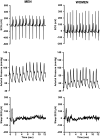Sex differences in blood pressure responsiveness to spontaneous K-complexes during stage II sleep
- PMID: 33300855
- PMCID: PMC7948112
- DOI: 10.1152/japplphysiol.00825.2020
Sex differences in blood pressure responsiveness to spontaneous K-complexes during stage II sleep
Abstract
K-complexes are a key marker of nonrapid eye movement sleep, specifically during stages II sleep. Recent evidence suggests the heart rate responses to a K-complexes may differ between men and women. The purpose of this study was to compare beat-to-beat blood pressure responses to K-complexes in men and women. We hypothesized that the pressor response following a spontaneous K-complex would be augmented in men compared with women. Ten men [age: 23 ± 2 yr, body mass index (BMI): 28 ± 4 kg/m2] and ten women (age: 23 ± 5 yr, BMI: 25 ± 4 kg/m2) were equipped with overnight finger plethysmography and standard 10-lead polysomnography. Hemodynamic responses to a spontaneous K-complex during stable stage II sleep were quantified for 10 consecutive cardiac cycles, and measurements included systolic arterial pressure (SAP), diastolic arterial pressure (DAP), and heart rate. K-complex elicited greater pressor responses in men when blood pressures were expressed as SAP (cardiac cycle × sex: P = 0.007) and DAP (cardiac cycle × sex: P = 0.004). Heart rate trended to be different between men and women (cardiac cycle × sex: P = 0.078). These findings suggest a divergent pressor response between men and women following a spontaneous K-complex during normal stage II sleep. These findings could contribute to sex-specific differences in cardiovascular risk that exist between men and women.NEW & NOTEWORTHY K-complexes during stage II sleep have been shown to elicit acute increases in blood pressure and heart rate, but the role of sex (i.e., male vs. female) in this response is unclear. In the present study, we demonstrate that the pressor response following spontaneous K-complexes were augmented in men compared to age-matched women. The augmented blood pressure reactivity to spontaneous K-complexes during stage II sleep in men advance the field of cardiovascular sex differences, with implications for nocturnal blood pressure control.
Keywords: blood pressure; nonrapid eye movement sleep; polysomnography; pressor response.
Conflict of interest statement
No conflicts of interest, financial or otherwise, are declared by the authors.
Figures


Similar articles
-
Blunted heart rate recovery to spontaneous nocturnal arousals in short-sleeping adults.Am J Physiol Heart Circ Physiol. 2021 Sep 1;321(3):H558-H566. doi: 10.1152/ajpheart.00329.2021. Epub 2021 Jul 30. Am J Physiol Heart Circ Physiol. 2021. PMID: 34328345 Free PMC article.
-
Sympathetic neural responses to 24-hour sleep deprivation in humans: sex differences.Am J Physiol Heart Circ Physiol. 2012 May 15;302(10):H1991-7. doi: 10.1152/ajpheart.01132.2011. Epub 2012 Mar 9. Am J Physiol Heart Circ Physiol. 2012. PMID: 22408018 Free PMC article.
-
Sex differences in dynamic blood pressure regulation: beat-by-beat responses to muscle sympathetic nerve activity.Am J Physiol Heart Circ Physiol. 2020 Sep 1;319(3):H531-H538. doi: 10.1152/ajpheart.00245.2020. Epub 2020 Jul 31. Am J Physiol Heart Circ Physiol. 2020. PMID: 32734818
-
Muscle sympathetic nerve activity and hemodynamic responses to venous distension: does sex play a role?Am J Physiol Heart Circ Physiol. 2019 Mar 1;316(3):H734-H742. doi: 10.1152/ajpheart.00702.2018. Epub 2018 Dec 28. Am J Physiol Heart Circ Physiol. 2019. PMID: 30592900
-
Sex differences in hemodynamic and sympathetic neural firing patterns during orthostatic challenge in humans.J Appl Physiol (1985). 2012 May;112(10):1744-51. doi: 10.1152/japplphysiol.01407.2011. Epub 2012 Mar 8. J Appl Physiol (1985). 2012. PMID: 22403351
Cited by
-
Disrupted Circadian Rhythm of Epinephrine in Males With Youth-Onset Type 2 Diabetes.J Endocr Soc. 2022 Dec 13;7(2):bvac190. doi: 10.1210/jendso/bvac190. eCollection 2022 Dec 15. J Endocr Soc. 2022. PMID: 36632209 Free PMC article.
-
Blunted heart rate recovery to spontaneous nocturnal arousals in short-sleeping adults.Am J Physiol Heart Circ Physiol. 2021 Sep 1;321(3):H558-H566. doi: 10.1152/ajpheart.00329.2021. Epub 2021 Jul 30. Am J Physiol Heart Circ Physiol. 2021. PMID: 34328345 Free PMC article.
-
Evening binge alcohol disrupts cardiovagal tone and baroreflex function during polysomnographic sleep.Sleep. 2021 Nov 12;44(11):zsab130. doi: 10.1093/sleep/zsab130. Sleep. 2021. PMID: 34015116 Free PMC article. Clinical Trial.
References
-
- Davis H, Davis PA, Loomis AL, Harvey EN, Hobart G. Electrical reactions of the human brain to auditory stimulation during sleep. J Neurophysiol 2: 500–514, 1939. doi:10.1152/jn.1939.2.6.500. - DOI
-
- Loomis AL, Harvey EN, Hobart GA. Distribution of disturbance-patterns in the human electroencephalogram, with special reference to sleep. J Neurophysiol 1: 413–430, 1938. doi:10.1152/jn.1938.1.5.413. - DOI
Publication types
MeSH terms
Grants and funding
LinkOut - more resources
Full Text Sources
Other Literature Sources
Miscellaneous

